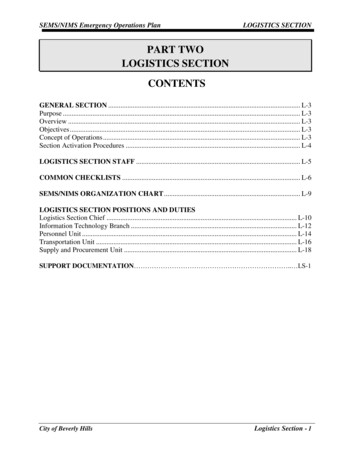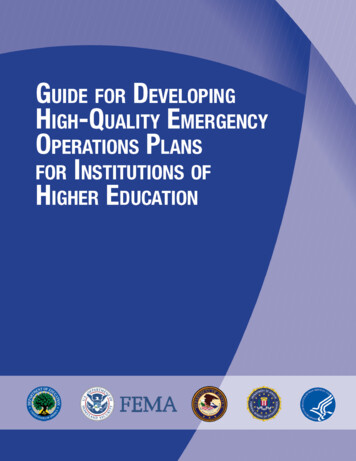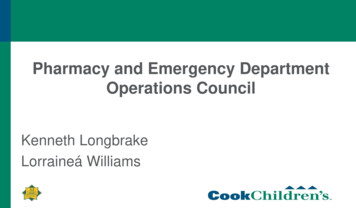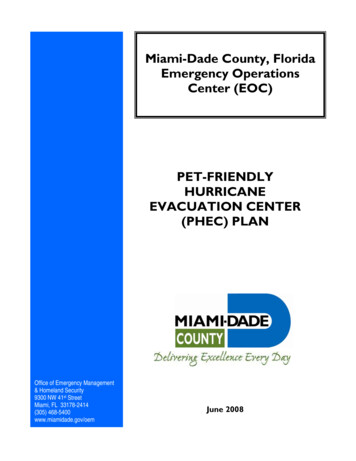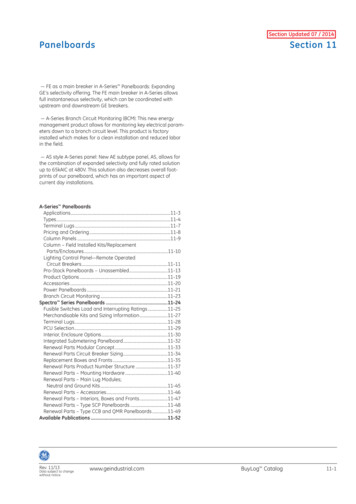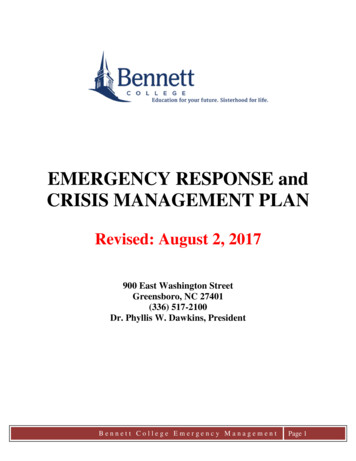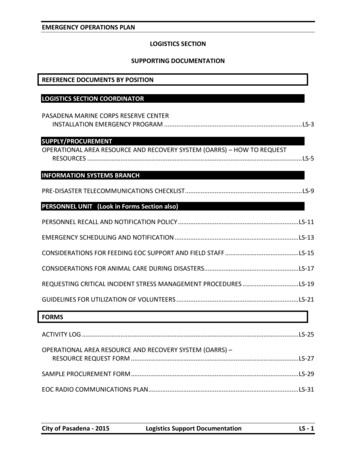
Transcription
EMERGENCY OPERATIONS PLANLOGISTICS SECTIONSUPPORTING DOCUMENTATIONREFERENCE DOCUMENTS BY POSITIONLOGISTICS SECTION COORDINATORPASADENA MARINE CORPS RESERVE CENTERINSTALLATION EMERGENCY PROGRAM . LS-3SUPPLY/PROCUREMENTOPERATIONAL AREA RESOURCE AND RECOVERY SYSTEM (OARRS) – HOW TO REQUESTRESOURCES . LS-5INFORMATION SYSTEMS BRANCHPRE-DISASTER TELECOMMUNICATIONS CHECKLIST . LS-9PERSONNEL UNIT (Look in Forms Section also)PERSONNEL RECALL AND NOTIFICATION POLICY . LS-11EMERGENCY SCHEDULING AND NOTIFICATION . LS-13CONSIDERATIONS FOR FEEDING EOC SUPPORT AND FIELD STAFF . LS-15CONSIDERATIONS FOR ANIMAL CARE DURING DISASTERS. LS-17REQUESTING CRITICAL INCIDENT STRESS MANAGEMENT PROCEDURES . LS-19GUIDELINES FOR UTILIZATION OF VOLUNTEERS . LS-21FORMSACTIVITY LOG . LS-25OPERATIONAL AREA RESOURCE AND RECOVERY SYSTEM (OARRS) –RESOURCE REQUEST FORM . LS-27SAMPLE PROCUREMENT FORM . LS-29EOC RADIO COMMUNICATIONS PLAN. LS-31City of Pasadena - 2015Logistics Support DocumentationLS - 1
EMERGENCY OPERATIONS PLANPage intended to be blank.City of Pasadena - 2015Logistics Support DocumentationLS - 2
EMERGENCY OPERATIONS PLANPASADENA MARINE CORPS RESERVE CENTERINSTALLATION EMERGENCY PROGRAMOverview:In accordance with Marine Corps Order 3440.9 it is the responsibility and the duty of allMarine Corps installations to, collaborate and coordinate with State, local and tribalgovernments; other Marine Corps agencies; other Services and HN emergency managers toachieve the highest possible level of Installation Emergency Management Program (IEMP)integration and inter-operability.Identify resources and partnership arrangements essential to the IEM program (e.g.Mutual Aid Agreements (MAA), Memorandum of Understanding (MOU), Memorandum ofAgreement (MOA), Inter Service Support Agreements (ISSA). Commanders may requireextensive Federal, State, local, tribal, other service, private support to effectively respond toand recover from an “all–hazard” incident. Close liaison with theses agencies and departmentsis to ensure that civil authorities and local Marine Corps resources will be prepared to mutuallysupport in the event of any “all hazards” incident.Preparations for (all-hazards) incidents:1.2.3.4.Identify all Local Civil Authorities for city and county.Build communication networking with these agencies.Establish disaster chain of command.Identify any additional requirements for communications, such as link up procedures ordesignated additional training as needed.5. The schedule and integrate training (drills) for all agencies.6. Ensure Local Civil Agencies are aware of the intent of this program.Level Response,Level One: Decentralized Coordination and Direction (Civil Agencies able to respond andcontain incident).1. Stand-To for all I&I personal, Recall initiated in preparation for potential escalation ofincident.2. Stage all needed personal and equipment.3. Establish and monitor 24 hour communication with Pasadena Emergency OperationCenter (EOC).4. Liaison Officer on standby for movement to EOC.Level Two: Centralized Coordination and Decentralized Direction (Civil Agencies request mutualaid from surrounding community)City of Pasadena - 2015Logistics Support DocumentationLS - 3
EMERGENCY OPERATIONS PLAN1.2.3.4.5.Stand-by for all I&I personal, Recall initiated muster all reservist.All I&I to remain on duty for up to 72 hours.Muster conducted Personal report to perspective support activity.RTC EOC stood-up, establish and monitor communication with Pasadena EOC.Liaison Officer moves to primary or alternate Pasadena EOC, report to EOC LiaisonOfficer.6. Load out all emergency equipment, standby for tasking from Liaison Officer.Level Three: Centralized Coordination and Direction (A local or State of Emergency will beproclaimed, local resources1. Stand-up, Recall initiated muster all personal to remain on duty for up to 72 hours.2. Muster conducted Personal report to perspective support activity for staging andassignment.3. Reserve Training Center EOC stood-up, establish and monitor communication withPasadena EOC.4. Liaison Officer moves to primary or alternate Pasadena EOC, report to EOC LiaisonOfficer.5. Load out all emergency equipment, standby for tasking from Liaison Officer.City of Pasadena - 2015Logistics Support DocumentationLS - 4
EMERGENCY OPERATIONS PLANOARRSResource Request “How To”Revised 2/1/2011Before you request from the county goods, services, equipment, personnel and facilities yourequire for emergency operations, make sure you have attempted to get the resources fromwithin your jurisdiction/agency or through normal channels such as existing agreements oryour normal procurement process.Note:Under certain circumstances, the requesting agency may incur costs associated with therequest.To print a copy of the How To guide, click on the How To tab in the Resource Request viewfor a link to the document. You can also access the guide by going to the References menuon the left side of the screen, then clicking on Document Library, then clicking on How Tofor a listing of all How To documents.To create a Resource Request:1. From the Center View screen, on the left hand side of the screen, you will see a menubar in blue.2. Scroll down and click on Resources.3. Click on Resource Request. This is the form used by all jurisdictions and other agenciesas well as county departments.4. In the Center View, just to right of the blue menu bar, at the top left you will see aCreate button. Click on it and a Resource Request will open.5. Priority: Click on the blue Priority Key for an explanation of the levels of prioritieswhen requesting resources. Once you have determined the priority level, from thedrop down menu select the priority of this request.6. Status: From the drop down menu, select the current status of this request. All newrequests will be BLACK.7. Tracking Number – Local: This field is automatically completed.8. Tracking Number- State: This will be completed if the request is being filled by thestate.9. Tracking Number – FEMA: This will be completed if the request is being filled throughFEMA.10. Tracking Number – EMAC: This will be completed if the request is being filled throughEMAC.City of Pasadena - 2015Logistics Support DocumentationLS - 5
EMERGENCY OPERATIONS PLAN11. Requesting Organization: Select your jurisdiction/agency from the drop down menu.12. Requestor’s Contact Info: This information will be automatically filled in based on theinformation in your Personal Profile. If you need to add additional contact information,click on the Expand button and a pop up box will give you space to add moreinformation.13. Related Event/Incident/Activity: Click on the Select button for a list of eventsand incidents to which this request is related.14. Display All Resources Requests Related to: Click on Display for a complete listing ofresource requests for the Event/Incident you selected in the Related Event/Incident/Activity field.15. Resource Category: From the drop down menu, select a category that most closelydescribes your request. Leave on Select One for a complete listing of all resourcecategories. If you select a category from the drop down menu, you will see only thelist for that particular Resource Type/Kind as each category has its own list ofresources. If the complete list does not appear, click on Clear to reset the list.16. Quantity: Enter the number17. Resource Type/Kind: If you do not find the resource you need in the drop downmenu, click on the Search/Add button. A pop up box will appear and you can addthe resource you need by entering the name in the Other box and then clicking onAdd.18. Qty Unit of Measure: From the drop down menu, make a selection or, if you don’t seethe correct unit of measure, click on the Search/Add button. A pop up box will appearand you can add the unit of measure you need by entering the name in the Other boxand then clicking on Add.19. When Needed: Click on the blue Set for a calendar and select a date and time.20. Mission: Describe the problem or how the resource will be used.21. Resource Must Come With: Check all boxes that apply to the resource. Use the Otherbox for additional information.22. Special Instructions: Use this area to provide any extra information to those whowould be providing the resource.23. Forward Request To:a. Individual: DO NOT USE!b. Organization/Location: From the drop down menu select CEOC Logisticsc. Position: From the drop down menu select Logistics Section Chiefd. Agency: DO NOT USE!e. Vendor: DO NOT USE!f. Summary of actions taken: DO NOT USE!g. Estimated Resource cost: DO NOT USE!24. Return to the top of the screen and click on Submit.City of Pasadena - 2015Logistics Support DocumentationLS - 6
EMERGENCY OPERATIONS PLANTo update or change a Resource Request:1. From the Center View screen, go to the blue menu bar on the left side and scroll up toAll/My Views/Forms and click on it.2. Next, click on All Views/Forms.3. In the Center View screen, you will see 4 types of categories listed:a. Emergency Event (E)b. Planned Event (P)c. Incident (I)d. Not Reported (NR)4. You will see ato the left of both Emergency Event and Incident.5. Click once on the symbol to “expand” the selection. Note: the symbol now changes toa downward symbol . Whenever an item is expanded, the arrow will point down.6. A list of all Events in the system will now appear.7. Scroll down to the Emergency Event or Incident to which you related your ResourceRequest and click on the8. If you can’t find your report, try looking in the NR category; when you find it, relate itto the correct event.9. All jurisdictions/agencies who have related resource requests, reports or incidents toan Emergency Event or Incident will now be listed with links to these various reportsand incidents highlighted in blue.10. Scroll down until you find Resource Requests. Scroll down to find yourjurisdiction/agency name (to the right of the reports). When you find yourjurisdiction/agency name, click on the blue link and your jurisdiction/agency ResourceRequest will now appear on the screen.11. To update the report, click on Update in the upper right corner.City of Pasadena - 2015Logistics Support DocumentationLS - 7
EMERGENCY OPERATIONS PLANPage intended to be blank.City of Pasadena - 2015Logistics Support DocumentationLS - 8
EMERGENCY OPERATIONS PLANPRE-DISASTER TELECOMMUNICATIONS CHECKLIST Consider establishing an out-of-area (sister city) contact point for employees’ and theirfamily members.List the number and location of all pay phones in and near your facility. This will be veryhelpful in the event that your phone system crashes.List the number and location of all fax and direct lines into your facility.Develop a list of employees and key vendors, suppliers and contractors which includestelephone numbers and addresses.Plan to maximize the fax machines. Printed copy is easily shared and not oftenmisunderstood. An outgoing fax posted on a wall provides a "briefing" tool for updatingincoming staff. These documents will also be helpful in creating the after-action report.Survey your organization to find out how many amateur/ham/DCS radio operators youhave. Do they have hand-held or mobile radios?COMMUNICATIONS OPTIONS Cellular phonesSatellite phonesE-mailFaxesModems utilizing radio frequencies instead of wires connect portable data devices toreliable radio networks (i.e., wireless communications, packet radio).Portable satellite telephoneFax, data and secure digitized voice is transmitted directly to a communications satellite.Portable two-way radios- Get written reciprocal agreements to share the frequencies of other emergencyagencies- Verify with your vendor that the two-way radios will be compatible with thefrequencies of the other agencies.- Consider renting when needed rather than purchase. Ensures access to the latest technology Establish operational requirements with the vendor. Establish billing, shipping andcontact information. Ensure that vendor can program rental radios to meet your requirements and shipthem out, fully charged on a short notice.Cellular phones vs. two-way radios- The time consumed by dialing and ringing makes cellular a slower choice for on-sitecommunications than two-ray radio.- The “one-to-one” cellular telephone format is often less efficient than the “one-tomany” concept that two-way radio users are familiar with.City of Pasadena - 2015Logistics Support DocumentationLS - 9
EMERGENCY OPERATIONS PLANPage intended to be blank.City of Pasadena - 2015Logistics Support DocumentationLS - 10
EMERGENCY OPERATIONS PLANPERSONNEL RECALL AND NOTIFICATION POLICYAND PROCEDURES FOR DISASTER RESPONSEEMPLOYEE RESPONSIBILITYThe citizens of Pasadena rely on City government for leadership and assistance in the event of adisaster. In response to such occurrences, it is imperative that all City employees be available toassist in this type of emergency response.The Government Code of the State of California Chapter 8 of Division 4 of Title 1 Section 3100:Declaration; Public Employees as Disaster Workers states: It is hereby declared that the protection of the health and safety and preservation of thelives and property of the people of the state from the effects of natural, manmade, orwar-caused emergencies which result in conditions of disaster or in extreme peril to life,property, and resources is of paramount state importance requiring the responsibleefforts of public and private agencies and individual citizens. In furtherance of theexercise of the police power of the state in protection of its citizens and resources, allpublic employees are hereby declared to be disaster service workers subject to suchdisaster service activities as may be assigned to them by their superiors or by law.The City’s Emergency Operations Plan and Chapter 2.370.080 of the City’s Municipal Code specifythat: The City Manager (or designee) may require emergency service of any City officer,employee or citizen, and may requisition necessary personnel or material of any Citydepartment or agency. In any emergency, City employees may be assigned, regardless of their JobDescription/Checklist Actions, any duties that they are capable of performing safely.In the event a disaster occurs during normal working hours: All City employees shall remain at work to provide for disaster relief if required. Department heads (or designee) shall be responsible for ensuring employees remain atwork. Department heads (or designee) shall authorize release of employees. Employees who leave without authorization may be subject to disciplinary action.In the event a disaster occurs beyond normal working hours: All employees in public safety operations shall respond to established emergencyresponse procedures for their departments. All non-public safety employees will be expected to report to work unless informedotherwise via automated phone systems, the media or the Emergency Alert System thatnon-essential employees are not required to report to work. Radio stations providinginformation: KFI 640AM, KFWB 980FM, and KNX 1070AM. All employees have an obligation to attempt, and continue to try contacting theirdepartment or the employee emergency call-in numbers to determine whether it isnecessary to report to work.City of Pasadena - 2015Logistics Support DocumentationLS - 11
EMERGENCY OPERATIONS PLANIn the event of an emergency in or affecting the City of Pasadena, City employees have beeninstructed in writing to call one of the emergency call-in numbers to receive further informationif, when and where they should report to work.RELEASE OF EMPLOYEES (by City Manager or designee authority)Only the City Manager (or designee) has the authority to order a general release of Cityemployees in the event of a disaster. However, the City Manager (or designee) may authorizedepartment heads (or their designee) to exercise their judgment in releasing individual employeesor work units to return home. Such decisions will consider the total scope of the emergency athand, including but not limited to, the following factors: The condition of local transportation routes; employees will not be permitted to leavework if doing so would exacerbate existing transportation problems; The availability of safe work sites and in the event of an extended stay, the availability offood and other support services and facilities; The need for City personnel; The scope of the disaster and the resources needed to respond; and Whether the need to provide support services for City employees would otherwiseinterfere with or detract from the efforts to respond to the disaster.RELEASE OF EMPLOYEES (by Department Head or designee authority)Notwithstanding the release authority of the City Manager (or designee), department heads (orappointed designees) may otherwise release employees by authorizing emergency leave orpersonal leave in the following cases: When an employee is psychologically or physically incapacitated to the degree thathe/she is unable to function effectively (provided that no employee will be releasedunless they are able to care for and transport themselves safely); When the City is unable to provide shelter or services to support the continuedpresence of the employee(s) at work; When the City Manager (or designee) has called for a general release of employees innon-disaster response positions and the department head (or designee) is aware thatthe employees will not be needed for disaster relief; and/or When the continued presence of the employee(s) at the work site would present adirect hazard.DEPARTMENTAL REQUIREMENTSThe primary responsibility for managing City employees during and following a disaster lies withthe individual operating departments. It is important for all departments to consider that eventhough their department may not have direct responsibility for disaster response; all employeesrepresent a valuable resource for disaster relief. All departments are, therefore, required todevelop an Emergency Operations Plan (EOP) to be submitted for review by the City'sEmergency Services Coordinator. Such plans shall assist in the identification of emergencyassignments. The departmental EOP will provide City employees with an effective means forresponding to emergencies and major disasters.City of Pasadena - 2015Logistics Support DocumentationLS - 12
EMERGENCY OPERATIONS PLANEMERGENCY SCHEDULING & NOTIFICATIONIn the event of a major disaster, or at the direction of the City Manager or his/her designee, anEmergency Scheduling Plan will be put into effect. It is the responsibility of individualdepartments to plan for staffing their departments and to provide staff to other Citydepartments during a disaster. Departments should have a staff "recall plan". In the event ofan earthquake, or other sudden disaster, scheduling will be put into effect automatically bydepartments and affected employees know ahead of time that they are to report for work.If em
OARRS Resource Request “How To” Revised 2/1/2011 Before you request from the county goods, services, equipment, personnel and facilities you require for emergency operations, make sure you have attempted to get the resources from within your jurisdiction/agency



